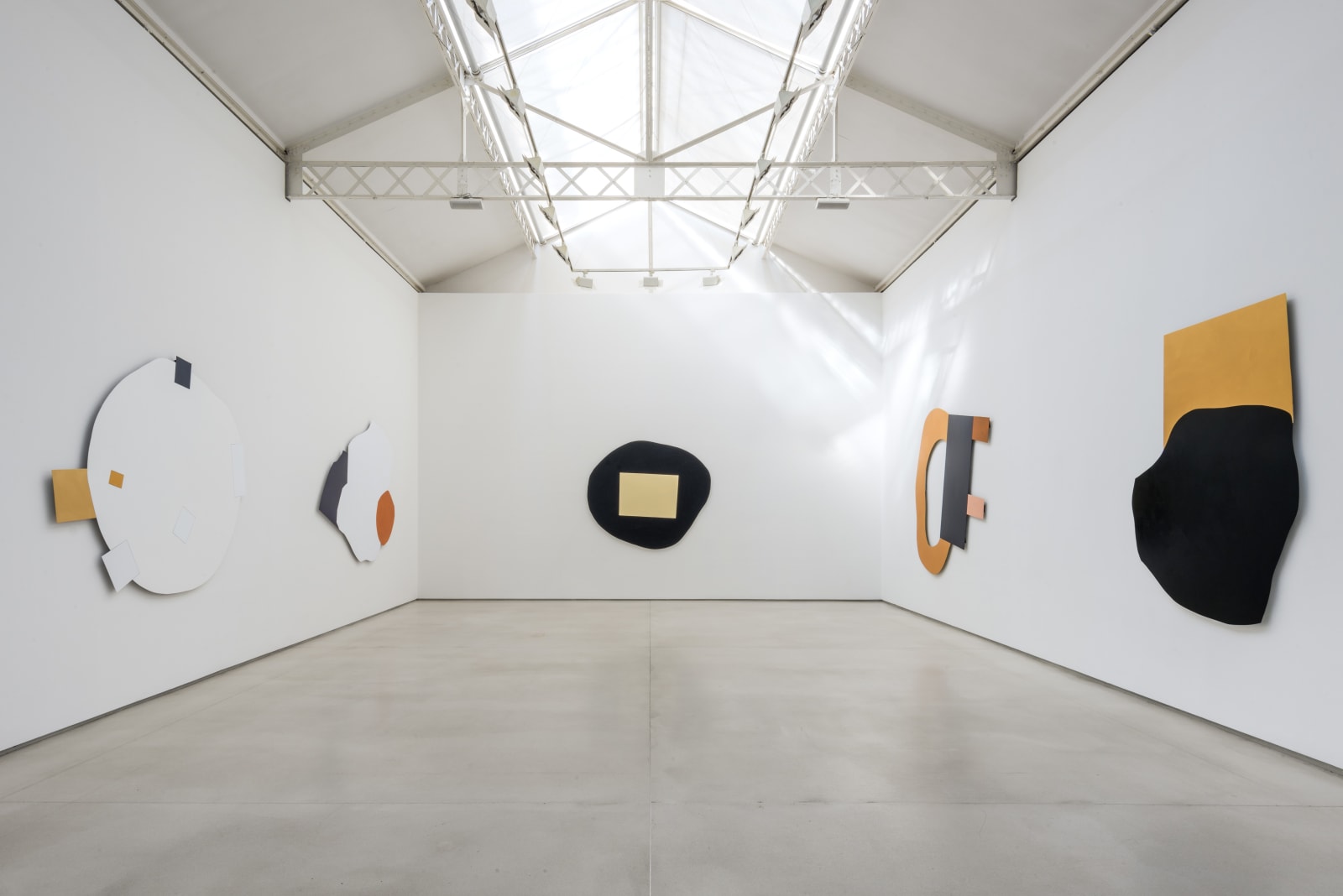

Overview
Liaison Astéroïde is composed of 22 acrylic-on-aluminum paintings that are presented in groupings of geometric panels. They are distinguished by an extremely precise and sensual construction, in addition to the development of colors and the pictorial quality of the material.
Galerie Thaddaeus Ropac is pleased to present the exhibition Liaison Astéroïde by Minimalist German artist Imi Knoebel, from 27 May to 2 July 2016 in the Marais gallery space in Paris.
This is Knoebel’s first exhibition in France since the completion of six monumental stained glass works, commissioned in 2011 in honor of the 800th anniversary of the Notre-Dame of Reims cathedral. Inducted permanently, they represent the artist’s first use of this medium, as well as his first commission for a religious building.
Liaison Astéroïde is composed of 22 acrylic-on-aluminum paintings that are presented in groupings of geometric panels. They are distinguished by an extremely precise and sensual construction, in addition to the development of colors and the pictorial quality of the material.
The exhibition title, which may seem unexpected at first, is in fact inspired by a real phenomenon, described in a scientific article published in 2014, upon the discovery of planet Itokawa’s composition, which was formed in the aftermath of two small variously-composed asteroids colliding. These fused and created a single misshapen asteroid “resembling a peanut,” the bottom of which consists of sandy and porous stone, while its top is composed of granitic and dense stone.
Fascinated by the misshapen aspect of this asteroid, Imi Knoebel considers the incoherence and the irregularity of the composition to be an integral part of its identity. The large format of his new series, presented at the ground floor of the gallery, addresses the concept of an amorphous body as an identity, founded upon the link between two distinct elements. He approaches these paintings as if possessed by double or even multiple personalities, where light and rectangular forms mix with round and circular forms, almost organically. Where these different forms coincide, Knoebel has chosen to let them overlap, and not to superpose them. Because of the differences in color and form, the observer at first maintains an impression of strata, so dear to the artist, but these are in fact erased, and leave room for a smooth and unified surface.
Other works - eight Bastards and two Flags, as well as five combinations of squares – are presented in the atrium of the ground floor and on the first floor of the gallery. The ensemble evokes a chaotic geometry of monochrome and bichromatic forms tending towards the rectangular. They each possess a perfectly straight and linear side in common, which reminds us of the dichotomy of this new ensemble of configurations.
With his new series, Imi Knoebel explores yet again the remarkable varieties of reduction and abstraction, all while upholding a subtle, timeless equilibrium. Like Malevich, his indeniable master, Imi Knoebel, here confirms his taste for emotional manipulation of geometry, aspiring to an almost metaphysical creation situated between spirituality and materiality.
In 2002 Max Wechsler discussed the “the poetry of Knoebel’s exactitude”, a term that describes “this presence of rationality and irrationality, of calculation and intuition, of reason and emotion that traverses the artist’s entire oeuvre” (Die Poesie der Genauigkeit, in the catalogue Imi Knoebel, Pure Freude, Kestner Gesellschaft Hanovre, 2002)
Seven paintings from the series Liaison Astéroïde were displayed for the first time in the exhibition Imi Knoebel – Works 1966-2014 at Kunstmuseum of Wolfsburg in 2014.
Imi Knoebel was born in Dessau, Germany in 1940. As of 1962-64, he studied applied arts at Darmstadt School of Arts and Crafts. Knoebel pursued research on the theories of Johannes Itten and Lászlo Moholy-Nagy, which were taught at the Bauhaus in Weimar and Dessau. Between 1964 and 1971, he studied at the Staatliche Kunstakademie in Düsseldorf, in Joseph Beuys’s atelier. After having experimented with line drawings, light projections, and white paintings (1972-75), he used color for the first time in 1974. In 1975, he began his series of rectangular paintings in superposed layers of Menninge paint (industrial anti-rust paint). Thereafter he started to juxtapose planes of vibrant and expressive colors upon different materials, in wood and metal.
He has had monographic exhibitions as of 1975 in Düsseldorf, Winterthur and Bonn in 1983, and Hamburg in 1992. In 1996, the Haus der Kunst de Munich exhibited a large retrospective. In 2002, the Kestner Gesellschaft in Hanover celebrated its 75th anniversary with an exhibition of Knoebel’s work. In 2008, the Dia Art Foundation (Beacon, NY) presented his series 24 Farben - für Blinky (1977), and the Neue Nationalgalerie in Berlin showed the most important works by the artist in Mies van der Rohe’s emblematic edifice in 2009. In parallel, the Deutsche Guggenheim Berlin exhibited the Deutsche Bank’s collection of Knoebel works. Under the heading Ich Nicht (Not Me), Knoebel answered the question Who’s Afraid of Red, Yellow and Blue? posed by Barnett Newman. Major exhibitions followed at Museum der Bildenden Künste Leipzig (2011), Kunstmuseum of Wolfsburg (2014), and at Kunstsammlung Nordrhein-Westfalen Museum Haus Esters in Krefeld (2015). Knoebel participated at the fifth, sixth and seventh editions of Documenta.
His works are included the public collections such as the Musée National d’Art Moderne, Paris; Dia: Beacon and Dia Art Foundation, New York; Bonnefantenmuseum, Maastricht; MMK, Frankfurt; Berardo Museum, Lisbon; Broad Contemporary Art Museum, Santa Monica; MoMA, New York; MOCA, Los Angeles; Museo Reina Sofia, Madrid; Hamburger Bahnhof, Berlin; Norton Museum, West Palm Beach; Sammlung Goetz, Munich, etc.
From 22 October 2016 to 23 January 2017, a large exhibition will be dedicated to Imi Knoebel’s work at the Musée Fernand Léger in Biot, France.













































































































































































